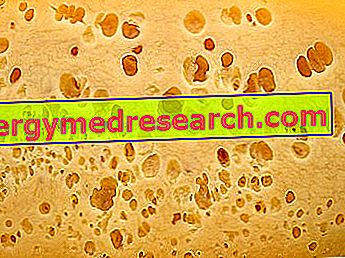Generality
Zinc protoporphyrin (ZPP) is a compound normally present in small quantities inside red blood cells (or erythrocytes).
Its determination is mainly used as a support to the diagnosis of lead poisoning and can help detect iron deficiency in children .
What's this
Most of the protoporphyrin present in red blood cells is bound to iron to form the EME group.
Premise: the EME group
The heme group is an essential component of hemoglobin, a molecule responsible for transporting oxygen from the lungs to all the organs and tissues of the body.
The formation of the EME group involves a series of steps that conclude with the insertion of an iron atom inside a molecule called protoporphyrin (PP) .

- Iron deficiency : this condition does not allow the formation of sufficient quantities of EME group;
- Presence of excessive quantities of lead : inhibits the formation of the EME group and increases the concentration of protoporphyrin in the blood; the zinc protoporphyrin is therefore formed as a metabolite in the presence of high concentrations of lead, since the latter interferes with the role of ferrochelatase in the bond between iron and PP.
ZPP is not able to bind oxygen, therefore it does not play the important role played physiologically by the EME group.
Why do you measure
The zinc protoporphyrin (ZPP) test measures its concentration in the blood. This assessment is useful in case of chronic exposure and / or suspected lead poisoning. Examination may also be required to detect iron deficiency in children and adolescents.
Lead poisoning - The use of the ZPP measure allows to evaluate the average level of exposure to lead (Pb) in the last 3-4 months.
This test can be requested together with the determination of lead levels (lead) in the context of monitoring for safety in the workplace or in people who, as a hobby, usually use products containing this element (such as paints used for the coloring of the glass).
Normal values
The concentration of ZPP in whole blood is usually very low.
Zinc protoporphyrin High - Causes
The increase in blood levels of zinc protoporphyrin depends mainly on:
- Lead exposure (dust inhalation or product handling);
- Iron deficiency anemia (due to iron deficiency).
ZPP can be high in the presence of serious infections, inflammatory states and hematopoietic disorders, but it is not generally used for monitoring or diagnosis of these diseases.
Protoporphyria and congenital erythropoietic porphyria are two rare hereditary diseases characterized by the presence of high levels of ZPP.
Zinc protoporphyrin Low - Causes
Low levels of zinc protoporphyrin are not usually associated with medical problems and / or pathological consequences, therefore they are not considered clinically relevant.
How to measure it
The determination of protoporphyrin zinc can be carried out in two ways:
- Measurement of free erythrocyte protoporphyrin (FEP) : doses both the concentration of ZPP (corresponding to about 90% of the protoporphyrin present in the erythrocytes), and the free protoporphyrin (not bound to zinc).
- Calculation of the ZPP / heme ratio : provides an indication of the amount of ZPP in relation to the amount of normal heme molecules (ie containing iron) present within the erythrocytes. In children, the extent of the ZPP / heme ratio is required as an early indicator of iron deficiency. The finding of an alteration requires however the execution of further tests for the formulation of a diagnosis of iron deficiency.
Free erythrocyte protoporphyrin (FEP) is measured in a blood sample obtained by venipuncture from the arm. For the determination of the ZPP / eme ratio, instead, it is sufficient to collect a drop of blood by pricking the fingertips; the sample thus obtained is then inserted into an instrument called a hematofluorimeter.
Preparation
Before undergoing the examination, the patient must observe a fast of at least 8-10 hours, during which a small quantity of water is allowed.
Interpretation of Results
An increase in protoporphyrin zinc is indicative of a disorder in normal heme group production, but does not identify its cause. The main causes of the increase in ZPP are iron deficiency and lead poisoning.
ZPP levels should be evaluated in the context of the patient's history, symptoms and the result of other tests such as ferritin, blood lead and complete blood parameter counts.
An increase in the ZPP / heme ratio in a child is mostly due to an iron deficiency. The decrease of this parameter following the administration of the mineral indicates instead the efficacy of the therapy.



